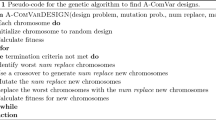Abstract
The paper deals with a method for the analysis of highly fractionated factorial designs proposed by Raghavarao and Altan in Metrika 58:185–191 (2003). We show that the method will find “active” factors with almost any set of random numbers. Once that an alias set is found active, Raghavarao and Altan claim that their method can resolve the alias structure of the design and identify which of several confounded effects is active. We show that their method cannot do that. The error in Raghavarao and Altan’s arguments lies in the fact that they treat a set of highly dependent (sometimes even identical) F-statistics as if they were independent.
Similar content being viewed by others
References
Al-Shiha AA, Yang SS (1999) A multistage procedure for analysing unreplicated factorial experiments. Biom J 41:659–670
Berk KN, Picard RR (1991) Significance tests for saturated orthogonal arrays. J Qual Technol 23:79–89
Box GEP, Hunter WG, Hunter JS (1978) Statistics for experimenters. Wiley, New York
Box GEP, Meyer RD (1986) An analysis for unreplicated fractional factorials. Technometrics 28:11–18
Box GEP, Meyer RD (1993) Finding the active factors in fractionated screening experiments. J Qual Technol 25:94–105
Daniel C (1959) Use of half-normal plots in interpreting factorial two-level experiments. Technometrics 1:311–341
Dong F (1993) On the identification of active contrasts in unreplicated fractional factorials. Stat Sin 3:209–217
Haaland PD, O’Connell MA (1995) Inference for effect-saturated fractional factorials. Technometrics 37:82–93
Kumert J (1997) On the use of the factor-sparsity assumption to get an estimate of the variance in saturated designs. Technometrics 39:81–90
Lenth RV (1989) Quick and easy analysis of unreplicated factorials. Technometrics 31:469–473
Raghavarao D, Altan S (2003) A heuristic analysis of highly fractionated 2n factorial experiments. Metrika 58:185–191
Voss DT (1999) Analysis of orthogonal saturated designs. J Stat Plan Inference 78:111–130
Zahn DA (1975a) Modifications of and revised critical values for the half-normal plot. Technometrics 17:189–200
Zahn DA (1975b) An empirical study of the half-normal plot. Technometrics 17:201–211
Author information
Authors and Affiliations
Corresponding author
Rights and permissions
About this article
Cite this article
Auer, C., Kunert, J. On a heuristic analysis of highly fractionated 2n factorial experiments. Metrika 63, 43–54 (2006). https://doi.org/10.1007/s00184-005-0005-z
Received:
Accepted:
Published:
Issue Date:
DOI: https://doi.org/10.1007/s00184-005-0005-z




